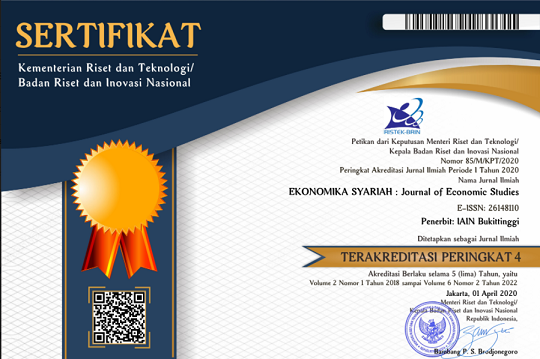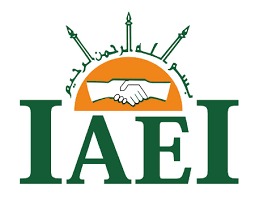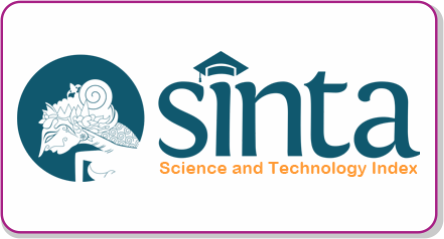Analysis of Rentability Trends of Islamic Commercial Banks in the Covid-19 Pandemic
DOI:
https://doi.org/10.30983/es.v6i2.5311Keywords:
Rentability, Trend Analysis, Pandemic, Commercial Banks, Rentabilitas, Analisis Trend, Pandemi, Bank SyariahAbstract
The Covid 19 pandemic has caused possible risks to the financial performance of Islamic banking. This study aimed to determine the rentability performance level predictions of Bank Muamalat Indonesia, Bank Mega Syariah, and Bank KB Bukopin Syariah by using the ratio of Return on Assets (ROA) and Return on Equity (ROE) in the pandemic for the period December 2021 to December 2023. The Islamic commercial bank was chosen because its rentability performance showed different trends during the pandemic. The research methods used the quantitative and trend analysis techniques with the least square method. The results have indicated that the rentability performance level of Bank Muamalat Indonesia and Bank KB Bukopin Syariah in terms of the ratio of Return on Assets (ROA) and Return on Equity (ROE) was predicted to decrease from December 2021 to December 2023. Meanwhile, the rentability performance level of Bank Mega Syariah in terms of the ratio of Return on Assets (ROA) and Return on Equity (ROE) was predicted to increase from December 2021 to December 2023. Concerning this, the research is hoped to contribute as reference material for further academic research and as material for consideration in determining policies for Islamic commercial banks.
References
Book
Dwi Suwiknyo, S E I, and Dwi Suwiknyo, “Analisis Laporan Keuangan Perbankan Syariah,†2017
Ismail, Perbankan Syariah (Jakarta: Prenadamedia Group, 2016)
Sugiyono, Metode Penelitian Kuantitatif Kualitatif Dan R&D (Bandung: Alfabeta, 2013)
Journal
Adnyana, Ni Kadek Ayu Trisnadewi, I Putu Agus, and Ni Luh Sri Kasih, “Nilai Pengelolaan LAR, DRR, Activity Ratio Terhadap Rentabilitas Di Masa Pandemi Covid-19 Pada LPD Desa Adat Lemukih, Kecamatan Sawan,†Jurnal Akuntansi Profesi, 13.1 (2020), 233–40
Aguspriyani, Yani, “Pengaruh Non Performing Financing (NPF) Terhadap Profitabilitas Bank Umum Syariah Di Indonesia Pada Masa Pandemi Covid-19,†Jurnal Kesilaman, Kemasyarakatan Dan, 22.1 (2021), 1–12
Azhari, Alselia Riski, and Rofiul Wahyudi, “Analisis Kinerja Perbankan Syariah Di Indonesia : Studi Masa Pandemi COVID-19,†Jurnal Ekonomi Syariah Indonesia, 10.2 (2020), 67–83
Dahlifah, Dahlifah, and Uun Sunarsih, “The Effect of Islamic Financial Ratio of Profitability,†in 5th Annual International Conference on Accounting Research (AICAR 2018) (Atlantis Press, 2019), pp. 193–96
Diana, Sri, Sulastiningsih Sulastiningsih, and Purwati Purwati, “Analisis Kinerja Keuangan Perbankan Syariah Indonesia Pada Masa Pandemi Covid-19,†Jurnal Riset Akuntansi Dan Bisnis Indonesia, 1.1 (2021), 111–25
Gunawan, Didik, Saparuddin Siregar, Sugianto, and Indriana Febrianti, “Analisis Komparasi Kinerja Pembiayaan Bank Umum Syariah Dan Unit Usaha Syariah Di Indonesia,†in Seminar Nasional Teknologi Komputer & Sains (SAINTEKS), 2020, pp. 691–95
Hasan, Mohammad Sofie Abdul, Adler Haymans Manurung, and Bahtiar Usman, “Determinants of Bank Profitability with Size as Moderating Variable,†Journal of Applied Finance and Banking, 10.3 (2020), 153–66
Ibrahim, Azharsyah, and Arinal Rahmati, “Analisis Solutif Penyelesaian Pembiayaan Bermasalah Di Bank Syariah : Kajian Pada Produk Murabahah Di Bank Muamalat Indonesia Banda Aceh,†Jurnal Kajian Ekonomi Dan Bisnis Islam, 10.1 (2017), 71–96
Jaya, Irfan Dwi, “Penerapan Metode Trend Least Square Untuk Forecasting (Prediksi) Penjualan Obat Pada Apotek,†Jurnal CoreIT, 5.1 (2019), 1–7
Juliandita, Eva, “ANALISIS TREN KEUANGAN PERBANKAN SYARIAH TAHUN 2019 SAMPAI TAHUN 2022,†Jurnal Khazanah Ulum Ekonomi Syariah (JKUES), 3.1 (2019), 1–7
Lasminiasih, Lasminiasih, and Mulatsih Mulatsih, “Analisis Kinerja Keuangan Koperasi Kasih Indonesia Berdasarkan Rasio Likuiditas, Solvabilitas, Dan Rentabilitas,†UG Journal, 14.2 (2021)
Lubis, Muhammad Zaky Mubarak, Ihsan Rahmat, Netta Agusti, and Andre Wiratha, “Analisis Trend Rasio Likuiditas Bank Muamalat Menggunakan Metode Least Square,†Jurnal Ekonomi Dan Perbankan Syariah, 8.2 (2022), 167–77
Madjid, Sitti Saleha, “Penanganan Pembiayaan Bermasalah Pada Bank Syariah,†Jurnal Hukum Ekonomi Syariah, 2.2 (2018), 1–15
Mukhtar, Afiah, and Syamsul Rinaldi, “Analisis Perbandingan Kinerja Keuangan Bank Konvensional Dan Bank Syariah Di Indonesia,†Jurnal Keuangan Dan Perbaankan, 1.2 (2019), 58–66
Puteri, H E, M Arifin, and H Arief, “Social Performance of Islamic Microfinance Institutions: Examining the Financial Sustainability as Driving Factor,†International Journal of Applied …, 4.2 (2022), 151–67 <https://doi.org/10.35313/ijabr.v4i2.146>
Putri, Nabila Rahmadani Kusuma, and Edy Yusuf Agung Gunanto, “Analysis of the Determinants of Sharia Commercial Bank’s Profitability for the Period of January 2015–December 2020,†EKONOMIKA SYARIAH: Journal of Economic Studies, 6.1 (2022), 18–29
Saputra, Yoga Fajar, Retno Endah Supeni, and Achmad Hasan Hafidzi, “Studi Komparasi Kinerja Keuangan PT. Bank Rakyat Indonesia Dan PT. Bank Negara Indonesia Pada Saat Pandemi COVID -19,†Jurnal Muhammadiyah Manajemen Bisnis, 2.2 (2021), 63–72
Saputri, Oktoviana, and Mulawarman Hannase, “Pengaruh Indikator Makroekonomi Terhadap Kinerja Keuangan Bank Umum Syariah Pada Masa Pandemi Covid-19,†Jurnal Tabarru’: Islamic Banking and Finance, 4.1 (2021), 139–51 <https://doi.org/10.25299/jtb.2021.vol4(1).6590>
Surya, Yoga Adi, and Binti Nur Asiyah, “Analisis Perbandingan Kinerja Keuangan Bank BNI Syariah Dan Bank Syariah Mandiri Di Masa Pandemi Covid-19,†IQTISHADIA Jurnal Ekonomi & Perbankan Syariah, 7.2 (2020), 170–87
Veno, Andri, and Syamsudin, “Analisis Trend Kinerja Keuangan Perbankan Syariah Tahun 2015 Sampai Dengan 2017,†Jurnal Bisnis Dan Manajemen Islam, 4.1 (2016), 21–34
Wahyudi, Rofiul, “Analisis Pengaruh CAR, NPF, FDR, BOPO Dan Inflasi Terhadap Profitabilitas Perbankan Syariah Di Indonesia: Studi Masa Pandemi COVID-19,†Jurnal At-Taqadum, 12.1 (2020), 13–24
Wardani, P S, and I Ismunawan, “Impact Pandemi Covid-19 Terhadap Rentabilitas Bank,†Jurnal Binis Dan Akuntansi, 23.1 (2021), 165–78
Wijaya, Rendi, “Analisis Perkembangan Return On Assets (ROA) Dan Return On Equity (ROE) Untuk Mengukur Kinerja Keuangan,†Jurnal Ilmu Manajemen, 9.1 (2019), 40–51
Website
Indonesia, Bank, “Surat Edaran BI No. 6/23/DPNP Perihal Sistem Penilaian Tingkat Kesehatan Bank Umum,†Bank Indonesia, 2004
Indonesia, CNN, “OJK Prediksi Risiko Kredit Macet Masih Menanjak. CNN Indonesia,†CNN Indonesia, January 2022
Muamalat, Bank, Laporan Triwulan Bank Muamalat, 2022
OJK, Laporan Keuangan Perbankan, 2022
———, “Peraturan Otoritas Jasa Keuangan Republik Indonesia Nomor 17/POJK.03/2021 Tentang Perubahan Kedua Atas Peraturan Otoritas Jasa Keuangan Nomor 11/POJK.03 Tentang Stimulus Perekonomian Nasional Sebagai Kebijakan Countercyclical Dampak Penyebaran Coronavirus,†2021, pp. 1–18
———, Statistik Perbankan Syariah, 2022
———, “Undang-Undang Nomor 21 Tahun 2008 Tentang Perbankan Syariah,†Otoritas Jasa Keuangan, 2008, pp. 1–64
Syariah, Bank KB Bukopin, Laporan Triwulan Bank KB Bukopin Syariah, 2022
Syariah, Bank Mega, Laporan Triwulan Bank Mega Syariah, 2022
Downloads
Submitted
Accepted
Published
Issue
Section
License
Authors who publish with this journal agree to the following terms:
- Authors retain copyright and grant the journal right of first publication with the work simultaneously licensed under a Creative Commons Attribution-ShareAlike 4.0 International License that allows others to share the work with an acknowledgment of the work's authorship and initial publication in this journal.
- Authors are able to enter into separate, additional contractual arrangements for the non-exclusive distribution of the journal's published version of the work (e.g., post it to an institutional repository or publish it in a book), with an acknowledgment of its initial publication in this journal.
- Authors are permitted and encouraged to post their work online (e.g., in institutional repositories or on their website) prior to and during the submission process, as it can lead to productive exchanges, as well as earlier and greater citation of published work (See The Effect of Open Access).












